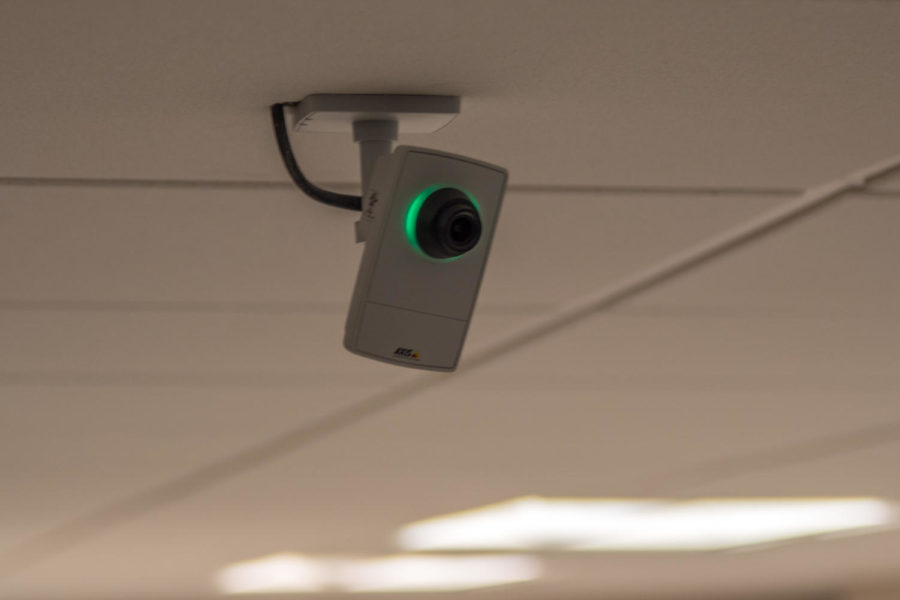- App Content
- App Content / News
- News
- News / Politics And Administration
- News / Politics And Administration / Campus
Cameras included in University Services’ plans for safer campus
A security camera keeps watch over the second floor of Carver Hall on Jan. 12.
January 12, 2017
University Services responded to overwhelming feedback for more safety measures with new initiatives including adding cameras throughout campus.
The College of Design, the Utilities Organization and several student organizations are working with University Services to heighten campus security. Four locations are currently being looked at as possible spots for cameras.
One would be on top of the Union Drive Community Center looking north on Bissell Road, one would be placed on the roof of the Gerdin Business Building looking down Farm House Lane and one looking out on Central Campus from the roof of Curtiss Hall.
The final webcam, which would be positioned on top of Parks Library, would have the ability to record, a capability the current camera does not have. The current camera, known as the West Lawn camera, only shows a live feed.
Katherine Gregory, senior vice president for University Services, plays a large role in campus safety on the Iowa State campus and in this project.
She said people change what they want over time and that 20 years ago, there were hardly any security cameras, except maybe at banks.
With improved technologies, these recording devices are used anywhere from public places to private properties.
Interim Police Chief Aaron Delashmutt also spoke to how these cameras can benefit the Iowa State Police Department and its daily work to keep the students, faculty and staff on campus safe.
“There’s been a number of cases over the years where outdoor cameras would have been helpful to at least give us a place to start on what happened,” Delashmutt said. “It’s really more about the safety of our community.”
Neither Delashmutt nor Gregory have heard any opposition to the plans for new cameras on campus. Delashmutt explained that concerns over privacy typically come into play, but that hasn’t been the case this year.
Gregory received overwhelming feedback in the fall that people want more help from the university to ensure that the campus is safe.
Another safety aspect that is being looked into is the amount of lighting on campus. A well-lit campus has obvious safety benefits and makes the area feel more inviting.
Randolph Larabee, assistant director of facilities, is dealing directly with not only the plans for cameras but also with plans to switch to LED-based lighting, which he said will take between four and six years.
Larabee has been here for 33 years. He recalled that when arrived in 1984, campus lighting was 30 percent of what it is today.
People’s wants and needs have changed over time with lighting as well. Gregory pointed out that 50 years ago, environmentally-friendly lights were not seen as necessary as opposed to today.
Those in the University Services office and other teams are looking at roads and sidewalks to see if anything needs to be redone. They also look at traffic and where pedestrians cross to ensure that moving around campus is safe.
“We have a lot of people on this campus,” Gregory said. “We have a lot of vehicles and skateboards and scooters and rollerbladers and walkers moving around.”
Plans to ensure that moving around campus is safe also include making the campus and its buildings more accessible and easier to move around in for those who are handicapped.
“I think a lot of times our campus can be challenging for [handicapped people] and so we are really looking hard at all of our infrastructure to make sure that the disabled community can easily and safely and comfortably and efficiently move around,” Gregory said.
She went on to add that on top of how articulate that those involved in campus safety planning try to be, they are not perfect and appreciate feedback whenever available.
Gregory said she and Larabee can be contacted with any feedback, which directly affects future projects that the university and Ames community members will look into.
“We really want input,” Gregory said. “[Students, faculty and staff] are experiencing campus every day, and all that input helps us know where we need to be, what we need to do, how we need to improve.”







